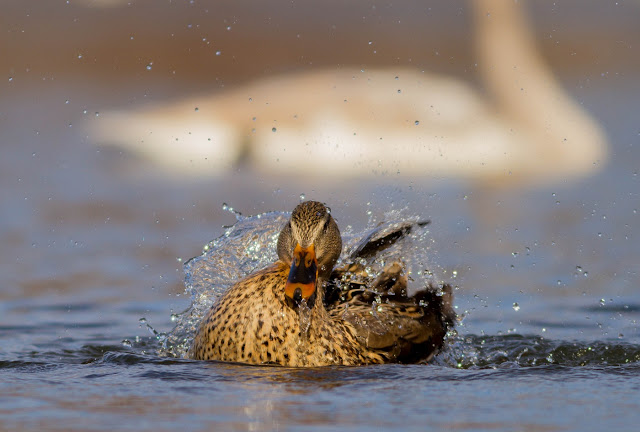Winter Waterfowl 21 February 2016

Mallard hen bathing and making a splash
From nearly fifty meters, the large open hole in the Saint Croix River ice sparkles mid-morning light toward me, and I wince slightly, placing my gloved hand over my eyes like the brim of a baseball cap. From where I approach, I must walk with the sun in my face, so there is no secret kept from the animals of this place. They will see me in full sun, and those that stay have accepted that I pose no threat. I hear the occasional hissing, tinkling rush as a floating raft of ice is jostled from upstream and bounces its way into the open pool. It passes by a crowd of mallards, geese and swans without raising as single feathered eyebrow. The birds are calm.
Trumpeter Swan, ready for a nap
Trumpeter Swan
I look through my lens and survey the pool of open water. I have positioned myself to get the sun as much to my back as possible, but there is some compromise. Finding perfect light would require a foolish dance across thin ice. At its best, the sun is glancing, the lateness of the day casting harsh blue tones and robbing me of the warm tones so often important to good wildlife photography. There is no doubt I have arrived too late to this place. I have missed the light.
Resting Trumpeter Swan, stretching a leg
Mallard pair, resting on the ice
As I study the situation, I begin to notice that the water is acting like a reflector of sunlight, bouncing the light upward into my face. I reason that if it is bouncing into my face, then maybe it is bouncing up into the feathers of the birds.
Subtle light ripples dancing on the wing of a swan...a first clue!
Light dancing on feathers... Perhaps, then, the better light would be found if I were to be under the birds, looking up at them rather then above them looking down into scattering light! I pull my Canon EF400mm lens off of the tripod and lay absolutely flat on the ice and snow. What I see is beautiful.
Mallard drake, rousing
Trumpeter Swan
I am an icy pancake. Neck muscles soon stiff, I take long breaks, laying my stocking hat on the ice and using it as a pillow. I rest my ear on the hat and watch the world of waterfowl from their eye level or even just below. I study the light and the dozens of enthusiastic personalities. They are mostly doing the regular sorts of things, and I don't immediately see anything too interesting. They are loafing, swimming, feeding, and occasionally bathing. In a strange moment, a slow-motion moment of sudden insight, I see water trickling down the side of a mallard. She has been bathing, and, having spent so long just watching, I begin to realize that the duck is far from static, far from just a mallard hen, far from just a portrait. She may be fairly static now, but when she bathed, she splashed. She created millions of dynamic moments that were free for the taking, spectacular moments that could only be captured at 1/2000th of a second. Excited by the opportunity, I eagerly search out a bathing mallard. It is time to capture the invisible!

















No comments:
Post a Comment